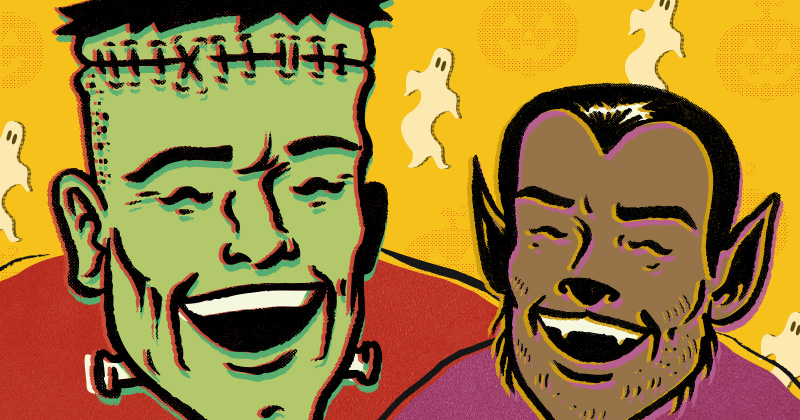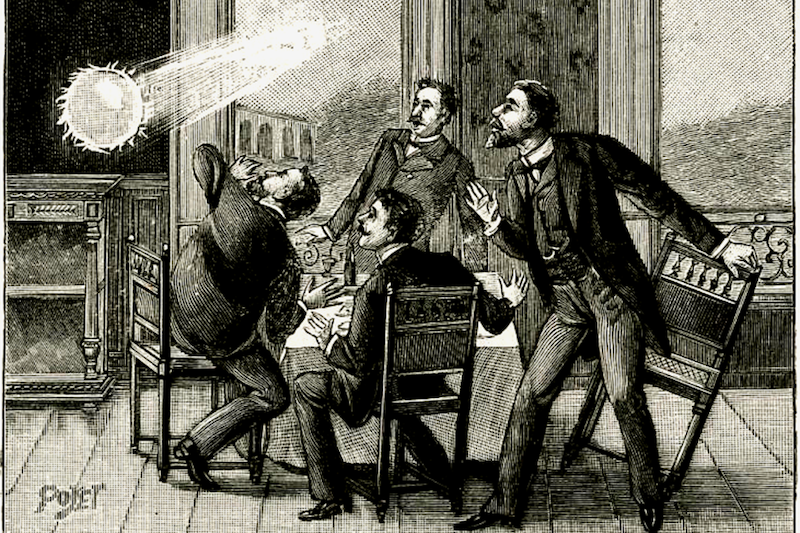


Spooky season
Illustration by Jaynell Keeley and Joy Smoker | Photos by Kathy F. Atkinson and public domain October 22, 2025
UD experts explore the fascination we have with ghosts and monsters
Leaves are falling, nights are getting longer and the days are becoming cooler, so naturally scary creatures have appeared on lawns and in windows around town, but have you ever wondered why?
Our modern celebration of Halloween has roots in the Celtic festival of Samhain, which marked the end of harvest season and was believed to be a day when the barrier between the living and the dead disappeared.
That explains the timing of Halloween, but not the why — why we are in turn fascinated and terrified by spectral beings and creepy creatures.
Below, University of Delaware faculty and students explore the history and meaning behind and popularity of monsters from film and fiction, and a local alumnus shares why we search for ghosts around campus — and where you might even find one.

Monsters throughout history
For centuries, monster lore has been associated with cultural differences.
“Western societies think about things in terms of good and evil, black and white, male and female, us and them,” said Persephone Braham, professor of Spanish and Latin American and Iberian studies in the Department of Languages, Literatures and Cultures; author of From Amazons to Zombies: Monsters in Latin America; and editor of the forthcoming Bloomsbury Cultural History of Monsters in the Long Eighteenth Century.
“Things that don’t fit the binary are often construed as monstrous,” she said. That is a very Western way of thinking, though. For many cultures, monsters confer prestige, help you get along with your neighbors or keep you company when you’re lonely.
Braham teaches about Latin American monsters and recently led an area studies course on monsters from around the world. She frequently gives talks on monsters in popular culture, like the Frankenstein movie franchise and Buffy the Vampire Slayer’s secret identity.

Siobhan Carroll, associate professor in the Department of English, calls those perceived cultural differences the “other.”
“Looking at the histories of monsters, you learn what cultures were frightened of in different periods of history, and often the fears that they are discussing are things that carry over and get animated in the present,” she said.
This semester she’s exploring monsters with her class Studies in Popular Fiction: Monsters and the Monstrous.
Senior music and psychology double major Isabella Trachina said she is a fan of Gothic literature and horror films, so she was intrigued to learn more about monster history.
“The background of different monsters is so interesting,” she said. “For example, zombies originated as a reaction to the fear of forced labor, and werewolves originated as a warning to girls about dangerous men.”
Fear and longing
Despite being feared — even loathed — monsters are also appealing, and not just because we enjoy being scared.
“One of the reasons we are fascinated by monsters, even as they scare us, is because they get to act out all the things that we are told we cannot be,” Carroll said.
Sophomore Mia Phelps is an honors double major in women and gender studies and criminal justice and a World Scholar who is taking Monsters and the Monstrous. A big fan of horror author Stephen King, Phelps said she enjoys learning about the dichotomy.
“Taking this class, I find monster culture to be much more fascinating, and now I look for cultural reflections within each individual story,” she said. “We love monsters because they cross boundaries that we as humans can only imagine crossing. They represent a sense of forbidden desire, and that feeling is intoxicating.”

Braham added that as stories get retold, and societal expectations change, so do our monsters.
“Bela Lugosi as Dracula was magnetic, but he wasn’t sexy,” she said. “Now we have Twilight and sparkle vampires and even sexy zombies in movies like Warm Bodies.”
Modern depictions reflect these changes. Ryan Coogler’s 2025 movie Sinners reframes vampires to tell a story of race in America, the Great Migration and the origin of the Blues.
Carroll’s class read Mary Shelley’s Frankenstein early in the semester, and Carroll said the 200-year-old tale is still relevant.
“It's got a lot in it, both about the ways in which societies produce monsters, as well as some really smart thinking about potential dangers of science and technology, particularly when it's allied with a single person's pursuit of their own profit or greed, basically,” she said.
It prepared students to explore Victor LaValle’s graphic novel Destroyer, a modern sequel to the original novel, where a grieving mother, Frankenstein's last descendent, resurrects her child after he has been killed in a police shooting.
As an author of horror fiction, Carroll describes how she would keep monsters relevant in her work.
“If I update a vampire story, or a zombie story, or a werewolf story, where do I think this cultural fear has gone that I can tell a new story about this monster?” she said.
But what about ghosts?
While monsters help us understand what a culture fears, ghosts tend to be more personal and familiar, like lost loved ones.
“They are both therapeutic, but in different ways,” Braham said. “Society creates monsters as embodiments of anxiety, and ghosts help us process our personal experiences.”
UD has its own share of ghost stories, including our most famous ghost John Edward Roach, who was stabbed during a kerfuffle between student groups in 1858 and bled to death in the main entrance of Old College. Roach has reportedly been responsible for strange noises and incidents in the building ever since.

UD alumnus and Newark resident Jim Jones is a retired history professor from West Chester University and conducts walking tours of the town for the Newark Historical Society and the City of Newark Department of Parks and Recreation, including ghost tours every October. He describes his interest in history as solving puzzles to discover why things are the way they are.
“I look at people who left the physical world unexpectedly or with unfinished business, and who might possibly have reason to come back and interact with the physical world,” Jones said of the ghost tour.
One of the stories he shares with his tours is about the family of Edward Lawrence Smith, appointed as UD’s second dean in 1915, who lived at 30 W. Delaware Avenue in the early 1900s. Jones isn’t aware of any eerie goings on at 30 W. Delaware, but as he put it, “a lot of people left that house against their will.”
The Smiths waited years to welcome a child into the home, only to have their daughter die before reaching age 6 when she was struck by a car on Delaware Ave. A few years later, both parents succumbed to the flu epidemic of 1918-1919, leaving their young son an orphan. The son lived with relatives for a few years, but Jones can’t find any trace of him in historical records past 1930.
So does Jones really believe in ghosts?
“I’m not in tune with glowing lights and all that, but I am certain that there is a physical world and a metaphysical world,” Jones said. “For a long time I thought of these stories as simple entertainment, but now I think people who go on the tour are interested in the boundary layer between the physical and the metaphysical. What is there? Does anybody really go back and forth? Maybe a ghost story will reveal something about that.”
Contact Us
Have a UDaily story idea?
Contact us at ocm@udel.edu
Members of the press
Contact us at mediarelations@udel.edu or visit the Media Relations website

